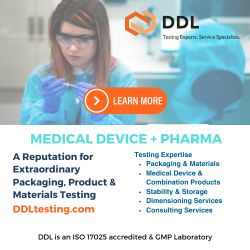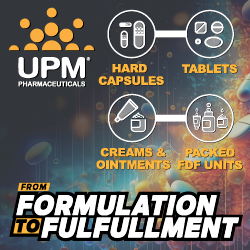Bio Platforms
Longeveron Announces Positive Results of Phase 1 Clinical Study of Lomecel-B Cell Therapy
Longeveron Inc. recently announced the final results of its Phase 1 clinical study evaluating the safety and efficacy of intravenous (IV) administration of Lomecel-B, an…
Akston Biosciences Launches Phase 1/2 Clinical Trial of Second-Generation COVID-19 Vaccine
Akston Biosciences Corporation recently announced the first participants have been dosed in an open-label trial of AKS-452, its COVID-19 vaccine candidate. The trial is managed…
Catalent Biologics Completes Madison Facility Expansion to Double Clinical & Commercial Drug Substance Capacity
Catalent recently announced it has completed the expansion of two new suites at its biologics drug substance development and manufacturing facility in Madison, WI, and…
Akouos Receives Orphan Drug & Rare Pediatric Disease Designations
Akouos, Inc. recently announced the US FDA has granted both Orphan Drug Designation (ODD) and Rare Pediatric Disease Designation (RPDD) for AK-OTOF, a gene therapy…
Yumanity Therapeutics Announces Study Demonstrating In Vivo Efficacy of YTX-7739 in a Glioblastoma Multiforme (GBM) Mouse Model
Yumanity Therapeutics recently announced results of a study that demonstrate in vivo efficacy, including increased median overall survival, of YTX-7739 in a mouse model for…
AzurRx BioPharma Initiates Phase 2 Clinical Trial of Niclosamide for the Treatment of COVID-19 Gastrointestinal Infections
AzurRx BioPharma, Inc. recently announced it has initiated its Phase 2 RESERVOIR clinical trial of a proprietary oral formulation of micronized niclosamide (FW-1022) for the…
uniQure Announces Completion of Enrollment in First Cohort of Phase 1/2 Clinical Trial of AMT-130 for the Treatment of Huntington’s Disease
uniQure recently announced the completion of patient enrollment in the first dose cohort of a randomized, double-blinded, Phase 1/2 clinical trial of AMT-130 for the…
New England Journal of Medicine Publishes Results of the PULSAR Phase 2 Trial of Sotatercept in Patients With Pulmonary Arterial Hypertension
Acceleron Pharma Inc. recently announced the New England Journal of Medicine has published results of the PULSAR Phase 2 trial of sotatercept in patients with pulmonary…
I-Mab & ABL Bio Announce First Patient Dosed in Phase 1 Trial of Bispecific Antibody TJ-L14B/ABL503 in Patients With Advanced or Metastatic Solid Tumors
I-Mab and ABL Bio, Inc. recently announced the first patient has been dosed in a Phase 1 trial for bispecific antibody TJ-L14B/ABL503. The Phase 1 clinical trial is an open-label….
Cidara Therapeutics Announces Agreement With Janssen to Develop & Commercialize AVCs for the Prevention & Treatment of Influenza
Cidara Therapeutics, Inc. recently announced it has entered into an exclusive worldwide license and collaboration agreement with Janssen Pharmaceuticals, Inc. to develop and commercialize….
Progenity & Ionis Pharmaceuticals Enter Agreement to Evaluate Progenity’s Ingestible Oral Biotherapeutics Technology for Delivery of Antisense Therapies
Progenity, Inc. recently announced an agreement with Ionis Pharmaceuticals to evaluate the safety, tolerability, and performance of Progenity’s Oral Biotherapeutics Delivery System (OBDS) for oral systemic delivery of….
Moderna & Catalent Announce Long-Term Strategic Collaboration for Dedicated Vial Filling of Moderna’s COVID-19 Vaccine & Clinical Portfolio
Moderna, Inc. and Catalent, Inc. recently announced the expansion of their strategic collaboration to dedicate a new high-speed vial filling line for the manufacture of the Moderna COVID-19 Vaccine and potentially other….
TCR² Therapeutics Establishes Commercial-Scale Cell Therapy Manufacturing Facility
TCR2 Therapeutics Inc. recently announced that it has signed a long-term, full-building lease with Alexandria Real Estate Equities, Inc. for an existing 85,000-sq-ft cell therapy…
Provectus Biopharmaceuticals Receives Notice of Allowance for Adult Solid Tumor Cancer Combination Therapy Patent
Provectus recently announced the United States Patent and Trademark Office (USPTO) has allowed US patent (USP) application 16/678,133, which covers the use of intralesional (aka…
Amphastar Pharmaceuticals Receives FDA Approval for Dextrose Injection
Amphastar Pharmaceuticals, Inc. recently announced that the US FDA approved the company’s Abbreviated New Drug Application (ANDA) for Dextrose injection 50% in the 50-mL Luer-Jet…
BridgeBio Pharma’s Affiliate QED Therapeutics & Helsinn Group Announce Strategic Co-Development & Commercialization Agreement
BridgeBio Pharma, Inc., through its affiliate QED Therapeutics, Inc., and Helsinn Group recently announced a global collaboration and licensing agreement to further develop and commercialize…
Pfizer-BioNTech Announce Positive Topline Results of Pivotal COVID-19 Vaccine Study in Adolescents
Pfizer Inc. and BioNTech SE recently announced that, in a Phase 3 trial in adolescents 12 to 15 years of age with or without prior evidence of SARS-CoV-2 infection, the Pfizer-BioNTech COVID-19 vaccine BNT162b2….
NUCLEAR β-CATENIN INHIBITOR - TBL1 - A Novel Target for Safe & Effective Blockade of the Nuclear β-catenin Signaling Pathway
Ruolan Han, PhD, explains how targeting TBL1/TBLR1 enables specific silencing of oncogenic Wnt target gene expression without affecting other necessary cellular functions that are disrupted when targeting higher up the Wnt pathway.
EXECUTIVE INTERVIEW - SDP Oncology: Uncovering New Biology
David J. Bearss, PhD, Chief Scientific Officer and Global Head of Research at SDP Oncology, discusses his company’s unique structure that has supported its robust research in the tumor immune microenvironment as well as its investigational assets being studied in this space.
Agios Shareholders Approve Sale of Oncology Business to Servier
Agios Pharmaceuticals, Inc. recently announced its shareholders voted to approve the previously disclosed sale of its commercial, clinical, and research-stage oncology portfolio to….
What are Bio Platforms?
Platforms (or asset-independent technologies to capture all kinds of capabilities that can be leveraged across many different drug candidate assets rather than just discovery tools that the term ‘platform’ immediately brings to mind) are ubiquitous in modern pharma. They are the product of an arms race, to secure access to the best capabilities in key areas.
Platform technologies are considered a valuable tool to improve efficiency and quality in drug product development. The basic idea is that a platform, in combination with a risk-based approach, is the most systematic method to leverage prior knowledge for a given new molecule. Furthermore, such a platform enables a continuous improvement by adding data for every new molecule developed by this approach, increasing the robustness of the platform.
But it has often been said that access to the latest technological platforms to aid efficient drug discovery and development is limited to Big Pharma, which can more easily justify the costs of creating and operating these platforms.
Benefits of Bio Platforms
Platform technologies have the ability to radically improve upon current products and generate completely novel products. In this sense, they open up new arenas for drug discovery and development, potentially increasing the number of therapeutic options for patients. Once a single compound or therapeutic has been generated and demonstrates a clinical benefit in patients, it is more likely this platform technology can successfully be applied to other therapeutic areas, derisking future compounds/products.
Complex drugs by their very nature are challenging and costly to manufacture. This, in turn, translates into higher costs for patients and other payers. In order to provide safe and effective therapies at a reasonable price, it is necessary for the industry to develop manufacturing technologies that reduce costs and provide a consistent product. While the initial investment may be larger, manufacturing costs will be lower over time as the manufacturing process is solidified.
Scale and Investment of Bio Platforms
Despite the initial upfront costs, platform technologies inevitably provide pragmatic solutions to production challenges, while yielding safer and more effective therapeutic products. It has often been said that one of the key features that distinguishes “Big Pharma” from biotech is access to the latest technological platforms to aid efficient drug discovery and development.
These platforms range from vast chemical libraries, ultra-high throughput screening and huge genetic databases in discovery, to predictive toxicology platforms, cutting-edge ‘omics’ and even deep-seated knowledge of particular therapeutic areas in development. All these platforms have two things in common: They can be used on any (or many) development candidate assets, and they cost huge sums to establish in the first place, and in a few cases each time they are used as well. Hence their restriction to the largest pharmaceutical companies (and a few of the so-called “big biotechs” that are, in many ways, indistinguishable from the old-guard pharma).
Only when you have hundreds of active projects can you justify the cost of creating and operating these platforms. Or so the mantra goes. It is access to these platforms that keeps the big companies ahead in the race to discover and develop the best medicines (or at least counterbalance the disadvantages of being large and slow-moving, depending on your point of view). But is that just an assertion? How much evidence is there to support the proposition that the efficiency gains due to these platforms outstrips the cost of creating and maintaining them?
Keeping these technologies “cutting edge” has become so expensive that increasingly we hear pharma companies talking of “pre-competitive” approaches to develop the next generation. A group of companies might develop a platform capability they then share. The principle goal of such initiatives is to access even grander and more expensive tools than individual companies could afford, rather than to dramatically cut costs (although sharing platforms rather than developing the same thing in parallel in each silo should at least keep a lid on rising costs).

















